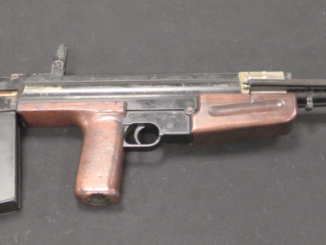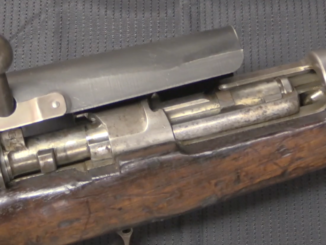The German military establishment during WWII has a reputation for innovation and excellence, which is pretty well deserved. But even they produced some real goose eggs, and the Gewehr 41 is one of them. That the G41 was even remotely successful is a tribute to the creativity of the Walther and Mauser engineering staffs, as the gun was fatally flawed from the start by the conditions put on the design. Primarily at fault was the military insistence that the barrel not have a gas port drilled in it. I’m sure there was some theoretical rationale for this requirement, but it was not a reasonable one. Some of the other restrictions were similarly silly, like the requirement that the gun must be able to operate like a bolt action using the same manual of arms as the K98k, and that there be no moving parts on the top surface of the gun (it is revealing that both Walther and Mauser flat out ignored one or more of these written requirements, despite being German companies). The root of the G41 procurement conditions can only really be a suspicious distrust of self-loading rifles that cropped up in many pre-WWII ordnance departments worldwide. It’s the same stubborn lack of foresight that produced repeating rifles with magazine cutoffs.
Anyway, Walther and Mauser both provided sample designs for the G41, and after trialling both, the Walther design was accepted for mass production (the Mauser design was rather more complex and intricate). The designs flaws were quickly realized, and production moved to the G43, which used essentially the same receiver but with a standard gas port system.
Our focus today is the G41, though, and we have put together a video explaining its inner workings:




Both G.41’s were clearly the result of assigning machinegun engineers to design a self-loading rifle – particularly the G.41M.
One of the Springfield Armory engineers who worked on Garand’s rifle design told me that the gas trap system was favored over gas port designs to reduce the effects of corrosion due to corrosive primers. Apparently, the early French autoloaders failed miserably in the trenches of WW I after only a few weeks. This is also why so much effort was expended on primer actuation and recoil designs.
Garand got the Ordnance Department to accept a gas port design after demonstrating the corrosion resistance of AISI Type 410 stainless steel in the gas tube forging.
I was looking through one of my books (I can’t remember which one….I have so many) and I saw a German soldier during the battle of Brest in Normandy in 1944 with a G41(W). I was really surprised to see him with it. Also, I know the locking lugs on the G41(W) weren’t all that successful but I think it was a really interesting idea! I really love older auto-loaders.
Don’t be surprised to see a lot of off standard equipment being used by German forces in the west during 1944 and 1945. All the new stuff was being shipped to the Eastern Front to replace the catastrophic losses then being incurred by Army Group Center.
An engineer here in Detroit had been a machine gunner on the Western Wall at Omaha Beach. He and all his fellow machine gunners had Polish versions of the Browning Model 1917 in 8x57mm! Not a Maxim, MG.34 or MG.42 anywhere.
RCS have not failed, at this time the World War 1 ended. Take look on RCS 1917/1918 system and after look the M1 Garand and you could be suprise of the similarities
I hate to ask, but do you have any information on the G41(M) coming up? Seeing this video made me check gunbroker where one is currently up for auction, and it looks more than just a little different.
I’ll probably have to pick up the Collector’s Grade Publication book on the subject from the curiosity you’re adding to.
How i can find locking mechanism for mauzer g41 w
Was it the case that the Søren Bang rifle design had a muzzle cap that was forced forward by the muzzle blast, thereby actuating an operating rod to unlock the bolt, while the G41 Walther here used a muzzle cone that ‘trapped’ gas in much the fashion of the original Garand design to push the operating rod?
Interesting video! Good thing hands were dry, clean and warm while fussing with the bolt assembly!
Yes, that is indeed the case.
Interesting that the “how do we make it go without a gas port?”* issue was being solved – very effectively – at the same time, by the people designing the MG42 (and if I understand the issue correctly, had been solved in a different way in the MG30).
With slightly different luck they could have had roller locking on the ’41 and had it be a great success… and with a little cleverness they probably could have met all three design considerations.
(* And presumably “without being a plain recoil action either”.)
Were the russian designs with the retracting lugs aranged to lock t the rear, any more forgiving of differences in dimensions?
On a more painful note; Was it the G41 which was responsible for your initiation into The Fraternal Order of the Black Thumbnail?
Ouch! whatever it was.
Bang and Garand muzzle cap designs were seen as a way to deal with the dual problems of high gas pressure neat the breech of the gun and limited access to the gas port (a real problem with highly corrosive ammunition). According to Hatcher, the Bang rifle was considered extremely reliable for its time, so it’s not too surprising that militaries in the interwar period would be keen to copy it or the similar Garand muzzle cap style operation.
Of course, more modern forms of gas operation, like the decoupled gas piston designs of the Tokarev and Simonov, and the M1 Carbine’s tappet mechanism, appear to work better, especially with noncorrosive ammunition.
Just stumbled on to your site and this video. I am very interested in your comment about the second guide rail being milled off when it was found to be unnecessary. One of my reference books, German Sniper Rifles by Pete Senrich (if I remember correctly)refers to the second guide rail as a late war design improvement. I have seen one G43 rifle (a late war 1945 manufactured rifle) with a second guide rail intact and it also did not have a switch on the bolt carrier. I believe your explanation is probably correct and that late in the war they just quit milling of the second guide rail and deleted the switch on the bolt carrier. I have one G41(W) duv43 that has evidence of the second guide rail being removed and both of my G43s (bcd43 & ac44)have similar evidence.
Great Site and Video!
Good day,
I am the owner of a Gewehr G41 (M) and grateful I stumbled upon your website. I see the the only similarity between the M & W is the tip of the barrel.
Any plans on running a story of video of the Mauser ?
I know it’s a shot in the dark but does anyone have any resources for the G41 M?
I am missing the clip spring and bayonet lug.
Thanks for all your info and work on keeping the history alive !
I can be reached at webmaster@carolinaskiffowner.com
Thanks in advance